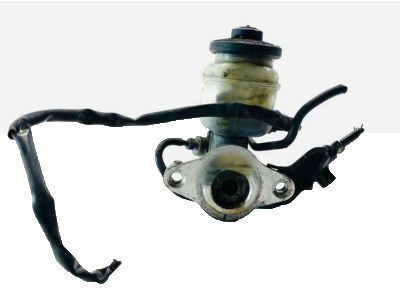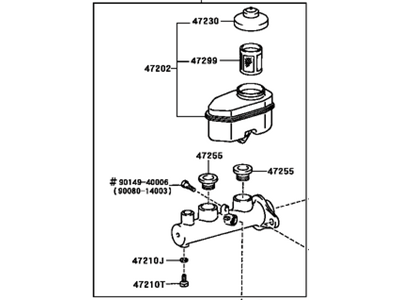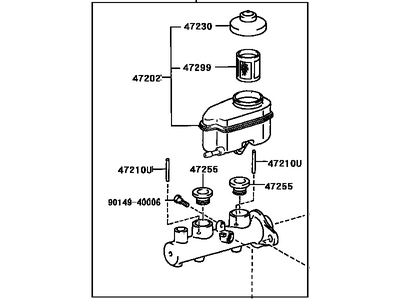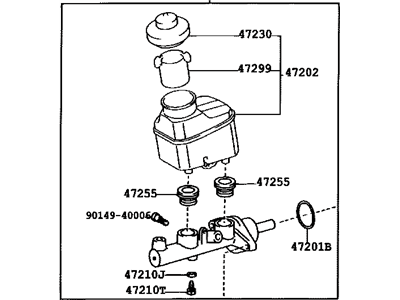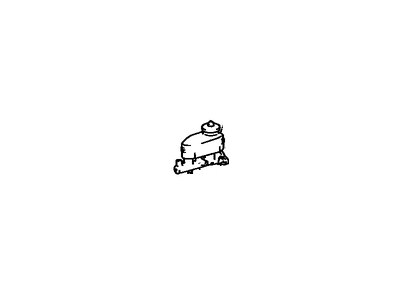

My Garage
My Account
Cart
Genuine Toyota Solara Brake Master Cylinder
- Select Vehicle by Model
- Select Vehicle by VIN
Select Vehicle by Model
orMake
Model
Year
Select Vehicle by VIN
For the most accurate results, select vehicle by your VIN (Vehicle Identification Number).
9 Brake Master Cylinders found
Toyota Solara Brake Master Cylinder Sub-Assembly
Part Number: 47201-07020$248.69 MSRP: $356.60You Save: $107.91 (31%)Ships in 1-3 Business DaysToyota Solara Brake Master Cylinder Sub-Assembly
Part Number: 47201-33210$202.76 MSRP: $290.73You Save: $87.97 (31%)Ships in 1-3 Business DaysToyota Solara Brake Master Cylinder Sub-Assembly
Part Number: 47201-33230$239.99 MSRP: $344.14You Save: $104.15 (31%)Ships in 1-2 Business DaysToyota Solara Brake Master Cylinder Sub-Assembly
Part Number: 47201-06290$229.09 MSRP: $328.49You Save: $99.40 (31%)Ships in 1 Business DayToyota Solara Brake Master Cylinder Sub-Assembly
Part Number: 47201-33191$244.75 MSRP: $350.95You Save: $106.20 (31%)
Toyota Solara Brake Master Cylinder
If you are in demand for superior quality and affordable OEM Toyota Solara Brake Master Cylinder, then shop with us! We own a wide range of the reduced-priced genuine Toyota Solara Brake Master Cylinder. You can purchase in confidence as all parts come with a manufacturer's warranty. Any issues with our products? No need to worry as we have a hassle-free return policy to guide you every step of the way.
Toyota Solara Brake Master Cylinder Parts Questions & Experts Answers
- Q: How to Remove and Install a Brake Master Cylinder on a 2002-2008 Toyota Solara?A:Unplug the electrical connector for the brake fluid level warning switch and remove as much fluid as possible from the reservoir with a syringe. Place rags under the fittings and prepare caps or plastic bags to cover the ends of the lines once they're disconnected, taking care to avoid spilling fluid as it can damage paint. Loosen the fittings at the ends of the brake lines where they enter the Brake Master Cylinder using a flare-nut wrench to prevent rounding off the flats. Pull the brake lines away from the Brake Master Cylinder and plug the ends to prevent contamination. Remove the nuts attaching the Brake Master Cylinder to the power booster and carefully pull the Brake Master Cylinder off the studs while avoiding fluid spillage. Bench bleed the new Brake Master Cylinder before installation by mounting it in a vise, attaching a pair of bleeder tubes to the outlet ports, and filling the reservoir with the recommended brake fluid. Slowly push the pistons into the Brake Master Cylinder using a large Phillips screwdriver to expel air into the reservoir, repeating the process until no more air bubbles are present. Remove the bleed tubes one at a time and install plugs in the open ports to prevent fluid leakage and air entry, adjusting the booster pushrod length if a new Brake Master Cylinder is being installed. Install the reservoir cover, then position the Brake Master Cylinder over the studs on the power Brake Booster, tightening the attaching nuts only finger tight initially. Thread the brake line fittings into the Brake Master Cylinder, ensuring it can be moved slightly for easier threading without stripping the threads. Fully tighten the mounting nuts and brake line fittings, then fill the Brake Master Cylinder reservoir with fluid and bleed both the Brake Master Cylinder and brake system. To bleed the cylinder on the vehicle, have an assistant pump the brake pedal several times slowly, then hold it to the floor while loosening the fitting nut to allow air and fluid to escape, repeating this until the fluid is clear of air bubbles. Ensure to have plenty of rags on hand to catch any fluid, as it can ruin painted surfaces, and test the operation of the brake system carefully before placing the vehicle into normal service.
